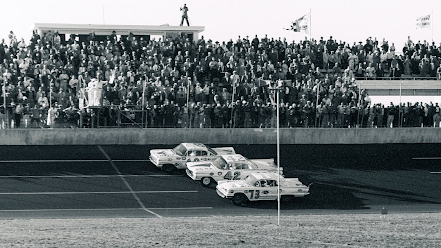Thunder at Daytona: The Birth of The Great American Race
The inaugural Daytona 500, held on February 22, 1959, marked a pivotal moment in motorsports, especially for NASCAR, a burgeoning racing series. This race wasn't just another event; it was a spectacle that would set the tone for the future of stock car racing in America. The mastermind behind this colossal event was Bill France Sr., a visionary who dreamed of building a track that would dwarf all others in speed, competition, and excitement. His dream materialized at the Daytona International Speedway, a 2.5-mile tri-oval that promised to push the limits of both machine and driver.
The day of the race dawned bright and clear, a perfect setting for what would become a historic event. The air was thick with anticipation as fans from across the country poured into the newly constructed stands, eager to witness the high-speed drama unfold on the asphalt stage below. The Daytona International Speedway, with its steep 31-degree bankings in the turns and 18-degree banking on the front stretch, was a marvel of engineering, a testament to France's ambition and foresight. Drivers and fans alike were excited and apprehensive about the challenges and dangers of such a fast track.
The race itself was a testament to the competitive spirit of NASCAR. With a field of 59 cars, the largest ever assembled at that time, the competition was fierce. Lee Petty, a seasoned racer and one of the early stars of NASCAR, found himself in a nail-biting battle that would go down in history. The race was characterized by close racing, dramatic lead changes, and an intensity that kept fans on the edge of their seats. The cars thundered down the asphalt, a symphony of roaring engines and screeching tires, as drivers jockeyed for position, pushing their machines to the limit.
The climax of the race was nothing short of cinematic. As the laps wound down, it became a three-way duel between Lee Petty, Johnny Beauchamp, and Joe Weatherly. The trio battled fiercely, swapping positions with each lap. As they crossed the finish line, Petty and Beauchamp were side by side in what appeared to be a dead heat. The crowd erupted in excitement, but confusion soon followed. Without the modern technology we take for granted today, determining the winner was not an immediate process. It took NASCAR officials three days of reviewing photographs and films from the race before declaring Lee Petty the winner by a margin so slim it was almost beyond belief.
The victory was a crowning achievement for Petty, cementing his legacy as one of the greats in NASCAR history. But beyond the personal triumph, his win at the first Daytona 500 symbolized the dawn of a new era in motorsports. The race had been an unequivocal success, drawing unprecedented crowds and proving that the Daytona International Speedway was a worthy cathedral for the high-speed drama of stock car racing.
The track itself received rave reviews from drivers and fans alike. Its design pushed the boundaries of what was possible, allowing for higher speeds and more competitive racing than ever before. For the drivers, it was both a thrilling challenge and a daunting test of their skills and courage. For fans, it offered an unparalleled spectacle of speed and competition. The success of the inaugural Daytona 500 laid the groundwork for the event to grow into "The Great American Race," a cornerstone of the NASCAR season and a beloved tradition for racing fans worldwide.
The history of racing in Daytona Beach dates back to the early 20th century, long before the construction of the Speedway. The hard-packed sands of Daytona Beach had been a proving ground for speed enthusiasts since 1903, hosting land speed record attempts and informal races. This tradition of speed laid the foundation for what would become one of the most iconic locations in motorsports. Bill France Sr.'s vision for a permanent racing facility in Daytona was born from this rich history, transforming the landscape of American motorsports forever.
The first Daytona 500 was more than just a race; it was a spectacle that captured the nation's imagination, a celebration of speed, competition, and innovation. It marked the beginning of a new chapter in the story of NASCAR, one that would see the sport grow from a regional curiosity to a national phenomenon. Through the roar of the engines, the crowd cheers, and the event's sheer audacity, the spirit of Daytona was born, a spirit that continues to define the essence of stock car racing today.



Comments
Post a Comment